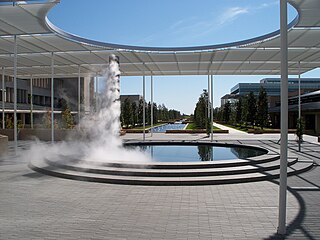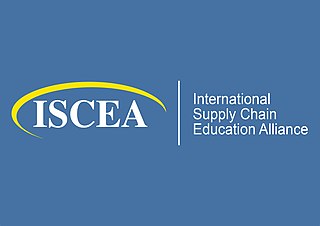Related Research Articles

Unisys Corporation is an American multinational information technology (IT) services and consulting company founded in 1986 and headquartered in Blue Bell, Pennsylvania. The company provides digital workplace, cloud applications & infrastructure, enterprise computing and business process services.
Radio-frequency identification (RFID) uses electromagnetic fields to automatically identify and track tags attached to objects. An RFID system consists of a tiny radio transponder, a radio receiver and transmitter. When triggered by an electromagnetic interrogation pulse from a nearby RFID reader device, the tag transmits digital data, usually an identifying inventory number, back to the reader. This number can be used to track inventory goods.

Near-field communication (NFC) is a set of communication protocols that enables communication between two electronic devices over a distance of 4 cm (1.57 in) or less. NFC offers a low-speed connection through a simple setup that can be used to bootstrap more capable wireless connections. Like other "proximity card" technologies, NFC is based on inductive coupling between two antennas present on NFC-enabled devices—for example a smartphone and a printer—communicating in one or both directions, using a frequency of 13.56 MHz in the globally available unlicensed radio frequency ISM band using the ISO/IEC 18000-3 air interface standard at data rates ranging from 106 to 848 kbit/s.

Telematics is an interdisciplinary field encompassing telecommunications, vehicular technologies, electrical engineering, and computer science. Telematics can involve any of the following:

Emergency evacuation is the urgent immediate egress or escape of people away from an area that contains an imminent threat, an ongoing threat or a hazard to lives or property.
The Computerworld Smithsonian Award is given out annually to individuals who have used technology to produce beneficial changes for society. Nominees are proposed by a group of 100 CEOs of information technology companies. The award has been given since 1989.

Zebra Technologies Corporation is an American mobile computing company specializing in technology used to sense, analyze, and act in real time, sometimes known as smart data capture. The company manufactures and sells marking, tracking, and computer printing technologies. Its products include mobile computers and tablets, software, thermal barcode label and receipt printers, RFID smart label printers/encoders/fixed & handheld readers/antennas, autonomous mobile robots (AMR’s) & machine vision (MV), and fixed industrial scanning hardware & software.
A tracking system, also known as a locating system, is used for the observing of persons or objects on the move and supplying a timely ordered sequence of location data for further processing.
The Emergency Management Assistance Compact (EMAC) is a mutual aid agreement among states and territories of the United States. It enables states to share resources during natural and man-made disasters, including terrorism.
The Getty Vocabulary Program is a department within the Getty Research Institute at the Getty Center in Los Angeles, California. It produces and maintains the Getty controlled vocabulary databases, Art and Architecture Thesaurus, Union List of Artist Names, and Getty Thesaurus of Geographic Names. They are compliant with ISO and NISO standards for thesaurus construction. The Getty vocabularies are the premiere references for categorizing works of art, architecture, material culture, and the names of artists, architects, and geographic names. They have been the life work of many people and continue to be critical contributions to cultural heritage information management and documentation. They contain terms, names, and other information about people, places, things, and concepts relating to art, architecture, and material culture. They can be accessed online free of charge on the Getty website.
Real-time locating systems (RTLS), also known as real-time tracking systems, are used to automatically identify and track the location of objects or people in real time, usually within a building or other contained area. Wireless RTLS tags are attached to objects or worn by people, and in most RTLS, fixed reference points receive wireless signals from tags to determine their location. Examples of real-time locating systems include tracking automobiles through an assembly line, locating pallets of merchandise in a warehouse, or finding medical equipment in a hospital.

Hurricane evacuation is the immediate and rapid movement of people away from the threat or actual occurrence of a hurricane. County judges, emergency managers and other officials may recommend a voluntary evacuation or order a mandatory evacuation.

The State Guard Association of the United States (SGAUS) is a non-profit organization advocating for the advancement and support of regulated state military forces, as established by state governments under the authority of federal law. The SGAUS encourages the establishment and advancement of regulated state forces through lobbying and affiliation with independent state associations.
A human microchip implant is any electronic device implanted subcutaneously (subdermally) usually via an injection. Examples include an identifying integrated circuit RFID device encased in silicate glass which is implanted in the body of a human being. This type of subdermal implant usually contains a unique ID number that can be linked to information contained in an external database, such as identity document, criminal record, medical history, medications, address book, and other potential uses.

The University of Texas at Dallas is a public research university in the University of Texas System. The University of Texas at Dallas main campus is located in Richardson, Texas.
Various schools have been using radio-frequency identification technology to record and monitor students.
Sahana Software Foundation is a Los Angeles, California-based non-profit organization founded to promote free and open-source software (FOSS) for disaster and emergency management. The foundation's mission statement is to "save lives by providing information management solutions that enable organizations and communities to better prepare for and respond to disasters." The foundation's Sahana family of software products includes Eden, designed for humanitarian needs management; Vesuvius, focused on the disaster preparedness needs of the medical community; and legacy earlier versions of Sahana software including Krakatoa, descended from the original Sahana code base developed following the 2004 Indian Ocean tsunami. The word "Sahana" means "relief" in Sinhalese, one of two national languages of Sri Lanka.

Dr. Erick Christopher Jones Sr. is dean of the College of Engineering at the University of Nevada, Reno, joining the college in September 2022.

The International Supply Chain Education Alliance (ISCEA) is a supply chain professionals certifying body best known for becoming the first organization validating the knowledge of supply chain managers around the world and providing them with the CSCM designation. Founded in 2003 and currently holding over 100,000 members, ISCEA has its World HQ office in Beachwood, OH, USA and regional offices in LATAM, EMEA and APAC. ISCEA's mission is to provide supply chain knowledge to manufacturing and service industry professionals worldwide through Education, Certification and Recognition. ISCEA is the governing body for the Ptak Prize.

The approach of Hurricane Rita towards the United States Gulf Coast in September 2005 triggered one of the largest mass evacuations in U.S. history. Between 2.5 and 3.7 million people evacuated from the Gulf coast, mostly from the Greater Houston area of Texas, with forecasts from the National Hurricane Center projecting Rita to strike the Texas Gulf Coast. Seeking to avoid a repeat of the devastation caused by Hurricane Katrina in parts of Louisiana and Mississippi less than a month prior, local officials began issuing evacuation orders on September 21 before the issuance of hurricane watches and warnings. Although evacuation orders anticipated smaller numbers of evacuees, uncertainties in projections of Rita's path and the fresh memory of Katrina's aftermath led many to evacuate, including from otherwise safe areas outside the scope of evacuation orders; approximately two-thirds of evacuees were not required to evacuate. The unexpectedly large scale of the evacuation overwhelmed Texas highways, producing widespread gridlock that was exacerbated by the implementation of previously unplanned contraflow on Interstates 10 and 45 while the evacuation was ongoing. Most traffic associated with the evacuation was clear of the threatened coastal areas by the early morning of September 23.
References
- ↑ "AT&T to Deliver Country's First Statewide Citizen-Evacuation Management System; Texas Governor's Division of Emergency Management to Implement RFID and Mobile Technologies, Providing Real-Time Information During Crises" (Press release). 2007-12-03. Archived from the original on 2008-03-02. Retrieved 2023-09-08.
- 1 2 Texas Turns to RFID for Emergency Evacuation System, 2008-01-03, archived from the original on 2008-02-20, retrieved 2023-09-08
- ↑ Computerworld Honors Program, 2008-06-02
- ↑ "Texas Guard members support Emergency Tracking Network training". Texas Guard. Retrieved 21 September 2017.
- ↑ "Emergency Tracking Network (ETN) Advisory Group". The Texas Division of Emergency Management (TDEM). Archived from the original on 2016-05-07. Retrieved 8 September 2023.